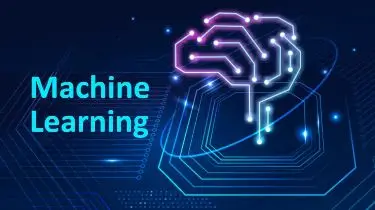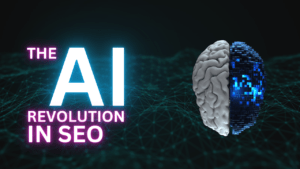So… What Is Machine Learning, Really?
Let’s clear something up right away.
A lot of people think machine learning is some kind of scary, sci-fi thing where robots take over the world. Nope. Not even close.
In reality, machine learning is already part of your everyday life. You just don’t realize it. When Netflix recommends a show you might like, or when your phone finishes your sentence while texting—that’s machine learning in action.
So, what is machine learning exactly?
At its core, it’s a way for computers to learn from data—without being explicitly programmed every time. Instead of telling a computer what to do step-by-step, we give it examples (data), and it figures out patterns on its own. Cool, right?
Still sounds a bit complex? Don’t worry. That’s what this blog is here for. We’re going to break it all down in simple terms; no tech degree is needed.
By the end, you’ll understand machine learning, how it works, where it shows up in your life, and why it matters.
Let’s dive in.
Machine Learning in Simple Terms (No Tech Talk, Promise!)
Okay, let’s put the jargon aside for a second.
Here’s a super simple way to define machine learning:
It’s like teaching a kid how to recognize fruits. You show the kid ten apples and ten bananas. After a while, they start to spot the differences—”Apples are usually red and round. Bananas are yellow and curved.” Next time they see a fruit, they make a guess based on what they’ve learned. That’s exactly how machine learning algorithms work—but with data instead of fruit.
In more technical terms (but still easy to follow), machine learning is a part of artificial intelligence (AI) where computers learn patterns from data and make decisions or predictions based on that.
So if you’re wondering, “What is machine learning in simple terms?”—it”‘s just a fancy way of saying, “We teach machines using examples, and they learn on their own.”
✅ Here’s a quick example:
Ever typed something into Google and it finishes your sentence? That’s machine learning.
When YouTube suggests a video you might like? Yep, machine learning again.
Even those spam filters in your email are powered by machine learning.
These are real-life examples of machine learning that we use every single day without realizing it.
🔍 But how is this different from regular programming?
In regular programming, you write every single rule. For example, if someone clicks a button, show a message.
In machine learning, you give the system lots of data (like 1,000 examples of emails labeled “spam” and “not spam”), and it figures out the rules on its own by spotting patterns.
This kind of learning can be:
- Supervised Learning: where the machine is trained with labeled data
- Unsupervised Learning: where it finds patterns without labels
- (We’ll dive into these types in another section.)
Why Should You Care?
Because machine learning is everywhere, and it’s changing how the world works. Businesses use it. Apps use it. Devices in your pocket use it.
And understanding it—even just a little—gives you an edge.
Whether you’re a student, a business owner, or just curious, getting a grip on what machine learning really is helps you keep up with today’s fast-paced tech world.
How Does Machine Learning Work? (Step-by-Step Breakdown)
A common myth people have is this:
“Machine learning is magic. You feed data in, and it just ‘knows’ what to do.”
Nope. It’s not magic—it’s math, logic, and a process that’s pretty easy to understand once it’s broken down.
So if you’ve ever wondered how machine learning works step by step, this section is just for you.
Let’s walk through it like a real-world scenario:
🔍 Imagine This…
You want to teach your computer to recognize whether an image has a cat or not.
Here’s the step-by-step process that happens behind the scenes:
✅ Step 1: Collect Data
First, you need lots of images. Some with cats, some without.
This is called training data—and it’s the fuel for any machine learning model.
✅ Step 2: Prepare the Data
The data needs to be cleaned, organized, and labeled.
You basically say, “Hey ML model, this one is a cat 🐱, and this one is not.”
This step is super important because poor data = poor results. You might’ve heard the phrase “Garbage in, garbage out.” That applies here.
✅ Step 3: Train the Model
Now the magic begins.
You feed the data into a machine learning algorithm—which is just a fancy name for the set of rules the computer uses to learn.
The algorithm starts to learn patterns. For example:
- Cats usually have pointy ears
- They appear in a certain shape
- They might have fur textures
The model adjusts itself over and over again until it gets better at recognizing those patterns.
✅ Step 4: Test the Model
After training, you test the model using new images it hasn’t seen before.
If it correctly identifies cats most of the time—awesome!
If not, you go back, tweak the algorithm or data, and train again.
✅ Step 5: Make Predictions
Once trained and tested, the model is ready to go live.
Now, whenever you feed it a new image, it can confidently say, “Yep, that’s a cat,” or “Nope, not a cat.”
This is the point where it starts doing what it’s made for—making predictions or automated decisions based on what it has learned.
🧠 Recap: Key Terms You Just Learned
- Training data: Labeled examples the model learns from
- Testing data: New data used to see how well the model performs
- Machine learning algorithm: A set of rules that guide how the model learns patterns
- Prediction: The result/output the model gives after learning
Pretty cool, right?
Different Types of Machine Learning (Yep, There’s More Than One)
Let’s bust another myth here real quick…
A lot of beginners think there’s only one type of machine learning. Like there’s just “one system” that learns.
Not true. In fact, there are three main types of machine learning, and each one works differently depending on the situation and the kind of data you’ve got.
Let’s break them down in the most beginner-friendly way possible. 👇
1️⃣ Supervised Learning
🔑 Keyword: “Learning with a teacher”
Think of this like teaching with examples and answers.
You give the machine a question + correct answer combo and let it learn from that.
For example:
- Input: Image of a cat
- Output: Label = “Cat”
After enough examples, it learns to recognize cats on its own.
This is the most common and widely used type.
You’ll find supervised learning in:
- Email spam detection
- Stock price prediction
- Customer churn prediction
- Facial recognition
It uses labeled data, which means each input already has the correct output attached to it.
2️⃣ Unsupervised Learning
🔑 Keyword: “Learning without a teacher”
Here, the machine is just given raw data—no labels, no correct answers.
It tries to find patterns or groupings all on its own.
For example:
- Feeding it customer purchase data
- It finds that some customers buy only in the morning, others late at night
- Now you have customer segments (without telling the system what to look for)
You’ll see unsupervised learning used in:
- Market segmentation
- Anomaly detection
- Product recommendations
- Customer behavior analysis
3️⃣ Reinforcement Learning
🔑 Keyword: “Learning by trial and error”
This one’s super interesting.
Think of it like teaching a dog tricks.
You give a reward for the right move, and it learns what works.
In ML, the model is placed in an environment and learns from feedback (like rewards or penalties).
Used in:
- Robotics
- Self-driving cars
- Game AI (like AlphaGo)
- Industrial automation
🎯 Bonus: Why Knowing the Types of ML Matters
Understanding these types of machine learning helps you figure out:
- What kind of data you need
- Which ML algorithm might work best
- How much labeling work is required
- How to approach real-world business problems with AI
Quick Summary:
| Type | Needs Labeled Data? | Learns From | Real-World Use |
|---|---|---|---|
| Supervised Learning | ✅ Yes | Example-Answer Pairs | Spam filters, predictions |
| Unsupervised Learning | ❌ No | Data Patterns | Grouping customers, insights |
| Reinforcement Learning | 👀 Sort of | Rewards & Penalties | Robotics, self-driving cars |
Real-Life Examples of Machine Learning You See Every Day
Let’s get one thing out of the way:
Machine learning isn’t just for tech geeks or big companies.
You probably use it 20 times before breakfast—and don’t even realize it.
So, if you’ve been asking, “Are there real life examples of machine learning that I actually use?”—the answer is a big YES.
Here’s how ML quietly runs the show behind the scenes of your daily routine:
🎬 1. Netflix & YouTube Recommendations
Ever notice how Netflix just knows what show you’ll binge next?
Or how YouTube lines up videos you’re weirdly in the mood for?
That’s machine learning in daily life at work.
These platforms use your viewing habits, what you skip, what you rewatch—and use that data to recommend stuff you’ll likely enjoy.
📧 2. Email Spam Filters
Those annoying spam emails that magically get filtered out?
Yep, machine learning again.
It looks at patterns (like shady links, weird subject lines) and learns what’s spam over time.
Every time you click “Report Spam,” you’re helping the algorithm learn better.
🛍️ 3. Shopping Apps & Online Stores
Ever added shoes to your cart and suddenly every site shows you sneakers?
That’s ML-powered marketing in action.
It learns from your browsing behavior and shows you personalized product suggestions.
E-commerce platforms like Amazon are masters at this.
🚗 4. Google Maps & Traffic Predictions
When Google Maps tells you which route to avoid—it’s not guessing.
It’s analyzing tons of real-time data (from other drivers), learning traffic patterns, and helping you save time.
Another great example of ML-powered apps working in the background.
📱 5. Voice Assistants (Siri, Alexa, Google Assistant)
Every time you say “Hey Siri” or “Okay Google,” you’re using machine learning models trained to recognize voice patterns, accents, and context.
And the more you use them, the better they get.
Because guess what? They’re still learning—from you!
🧠 TL;DR: You Use Machine Learning Every Day
From your inbox to your GPS, shopping, and even music playlists (hello, Spotify!), ML applications in daily life are everywhere.
And these are just the surface-level examples. Let’s zoom out and see how it’s being used in the real world on a much bigger scale.
What Is Machine Learning Used For Today? (Real-World Use Cases)
Let’s bust one more common belief:
“Machine learning is just a research topic—it’s not practical.”
Wrong. It’s super practical. In fact, it’s changing the way industries work.
So, if you’re wondering what is ML used for today, here’s your answer:
It’s being used to solve real problems in healthcare, finance, education, business, and way more.
🏥 1. Machine Learning in Healthcare
Doctors and researchers are now using ML to:
- Predict diseases early (like cancer or diabetes)
- Analyze X-rays and MRI scans faster
- Suggest personalized treatments based on patient history
It helps reduce human error and improves diagnosis accuracy.
Real impact. Real lives saved.
💰 2. Machine Learning in Finance
Banks and fintech apps love ML. Why?
Because it helps:
- Detect fraud in real-time
- Approve loan applications faster
- Personalize financial advice
- Analyze market trends
You’ve probably used ML-powered banking apps without realizing it.
🎓 3. Machine Learning in Education
ML is being used in smart education platforms to:
- Personalize learning paths for students
- Predict which students need extra help
- Automate grading
Apps like Duolingo and Khan Academy use ML algorithms to make learning feel more like a game—and more effective.
📈 4. Machine Learning in Business & Marketing
Businesses use ML to:
- Understand customer behavior
- Optimize ads (ever notice how you suddenly get ads for something you just thought about?)
- Improve user experience with chatbots and automation
From startups to big brands—machine learning for business is booming.
🚘 5. Machine Learning in Self-Driving Cars
Self-driving technology heavily depends on reinforcement learning (yup, one of the types we covered earlier).
These cars learn how to react to different situations on the road by gathering more and more data over time.
This is no longer science fiction—it’s happening right now.
🧾 Wrap-Up: Machine Learning Is Already Changing the World
So, if you thought ML was just for tech blogs and coding nerds—think again.
It’s helping:
- Doctors diagnose faster
- Banks fight fraud
- Students learn smarter
- Cars drive safer
- Businesses grow faster
And this is just the beginning.
Difference Between AI, ML, and Deep Learning (Simple Comparison)
Let’s kill one of the biggest confusions right away:
AI and Machine Learning are not the same thing.
And no, Deep Learning isn’t a cooler name for Machine Learning either. They’re related, yes. But they’re not interchangeable.
If you’ve been Googling things like “difference between machine learning and artificial intelligence” or “machine learning vs deep learning”, let’s make this super simple.
📊 Think of it like a Russian Doll Set:
- Artificial Intelligence (AI) is the big doll—the broad concept.
- Inside AI, we have Machine Learning (ML)—a smaller doll that helps machines “learn” from data.
- Inside ML, there’s an even smaller doll called Deep Learning (DL)—which is a type of machine learning based on neural networks.
Let’s break it down.
🤖 What is Artificial Intelligence (AI)?
AI is the overall idea of making machines act smart.
It’s about designing systems that can solve problems, understand language, play games, recognize faces, and more.
It doesn’t always have to learn from data—some AI systems are rule-based.
🧠 Examples of AI:
- Chatbots
- Smart assistants like Siri
- Chess-playing programs
- Customer service bots
💻 What is Machine Learning (ML)?
ML is a subset of AI. It’s all about machines learning from data to improve over time without being manually programmed for every single task.
The key? Data and pattern recognition.
🧠 Examples of ML:
- Email spam filters
- Netflix recommendations
- Fraud detection in banks
So, AI is the concept and ML is the method.
🧠 What is Deep Learning (DL)?
Deep Learning is a type of ML that mimics how the human brain works—through “neural networks.”
It’s perfect for handling big, unstructured data like images, videos, or speech.
🧠 Examples of DL:
- Face recognition on your phone
- Voice assistants understanding accents
- Autonomous driving (self-driving cars)
🧾 Quick Comparison Table
| Concept | What It Means | Uses Data? | Real-Life Example |
|---|---|---|---|
| AI | Smart systems mimicking human behavior | Not always | Siri, ChatGPT, chatbots |
| Machine Learning | Machines learning from data | ✅ Yes | Netflix, Gmail spam filter |
| Deep Learning | ML using neural networks | ✅ Yes | Face ID, Tesla Autopilot |
So next time someone says “AI,” you’ll know exactly where machine learning and deep learning fit in.
And yep, now you can explain it better than most people on Twitter.
How to Start Learning Machine Learning (Beginner’s Path)
Now you might be wondering…
“Okay, I get it. But how do I actually start learning machine learning?”
Good news—you don’t need to be a math wizard or computer science major to get started.
There are tons of beginner-friendly paths that make it easy and even fun.
So if you’re looking for the easiest way to get started with machine learning, this guide’s for you.
✅ Step 1: Understand the Basics
Before jumping into code, get the concepts down.
Watch beginner videos or read simple blogs (like this one 😎).
📚 Learn about:
- What is machine learning (you’ve already nailed this!)
- Supervised vs unsupervised learning
- What algorithms actually do
Use long tail keywords like:
- machine learning for absolute beginners
- best explanation of machine learning
✅ Step 2: Learn Python (Just Enough to Start)
Python is hands-down the most popular language for ML.
But don’t stress—you only need the basics to begin.
Focus on:
- Variables
- Loops
- Functions
- Lists and dictionaries
Use platforms like:
- Codecademy
- SoloLearn
- YouTube (search: “Python crash course”)
✅ Step 3: Try Beginner-Friendly ML Courses
The internet is packed with courses built for total newbies.
Here are some free (or cheap) ones to kick things off:
- Google’s Machine Learning Crash Course
- Coursera – Machine Learning by Andrew Ng
- Kaggle Learn – Python and ML tracks
- freeCodeCamp – Full ML Playlist on YouTube
These will help you learn machine learning step by step—even if you’ve never coded before.
✅ Step 4: Play With Real Data (Hands-On Projects)
Don’t just watch—build!
Try mini projects like:
- Spam detector using email data
- Predict house prices with historical data
- Movie recommendation system
These help you practice using:
- Training data
- ML algorithms
- Making predictions
Use tools like:
- Jupyter Notebook
- Google Colab (totally free)
- Kaggle Datasets
✅ Step 5: Join ML Communities
Learning is way more fun with others.
Join:
- Reddit’s r/MachineLearning
- Discord ML servers
- Kaggle discussions
- LinkedIn groups for beginners
Ask questions. Share progress. Get unstuck.
✨ Pro Tip:
Focus on progress, not perfection.
You don’t need to master everything overnight.
Just keep learning a little each day, and in a few months, you’ll surprise yourself.
Top Tools & Programming Languages for Machine Learning in 2025
If you’re serious about diving into machine learning, you need the right tools, frameworks, and languages to build, train, and deploy models.
But don’t worry—you don’t need to learn them all. Start small.
Let’s go through the most popular tools and languages for machine learning in 2025 that both beginners and pros are using.
🐍 1. Python (The King of ML Languages)
Still the #1 choice in 2025 for machine learning.
Why?
- It’s beginner-friendly
- Tons of ML libraries (like Scikit-learn, TensorFlow, PyTorch)
- Massive community and support
Whether you’re doing deep learning, data cleaning, or model training, Python is where most of the action is.
✅ Keyword Variations:
best programming language for machine learning, python for machine learning, python machine learning 2025
💻 2. R (Great for Data Science and Stats)
R is powerful for data analysis, statistical modeling, and visualization.
It’s mostly used in academic or research environments, and by data scientists who deal with tons of numbers and charts.
Pros:
- Beautiful plots with
ggplot2 - Great for exploratory data analysis
- Integrates well with machine learning workflows
✅ Use if you’re from a statistics background or love data visualization.
⚙️ 3. TensorFlow (by Google)
TensorFlow is a machine learning and deep learning framework created by Google.
Used for everything from image recognition to language translation to self-driving car software.
You can run it on CPUs, GPUs, and even mobile devices.
👍 Great for:
- Neural networks
- Large-scale machine learning
- Production-ready ML apps
✅ TensorFlow 2.0 and above has become much more beginner-friendly.
🔥 4. PyTorch (by Meta / Facebook)
If you prefer writing clean, readable ML code, PyTorch is your friend.
Why devs love PyTorch in 2025:
- Simpler to debug than TensorFlow
- More intuitive syntax (closer to Python)
- Widely used in research and AI startups
PyTorch vs TensorFlow is still a debate, but both are solid.
✅ Use PyTorch if you’re building deep learning models and want quick experiments.
📦 5. Scikit-Learn (The OG ML Library)
This one’s a must for classic ML algorithms like:
- Linear Regression
- Decision Trees
- Random Forest
- SVMs (Support Vector Machines)
It’s simple, powerful, and perfect for beginners.
✅ Great for supervised learning and small-to-mid datasets.
📈 6. Keras (Now part of TensorFlow)
Keras is a high-level API built on top of TensorFlow.
It’s ideal if you’re a beginner who wants to get into deep learning fast.
👍 Why people love Keras:
- Clean syntax
- Super beginner-friendly
- Great documentation
✅ Perfect if you’re into neural networks but hate complex code.
🧪 7. Jupyter Notebook & Google Colab
These are not coding languages, but essential tools for every ML learner.
- Jupyter Notebooks let you run code, see outputs, and write notes—all in one place.
- Google Colab is like Jupyter in the cloud. It’s free, powerful, and even lets you use GPUs.
✅ Best for learning, quick tests, and building mini-projects without setting up anything on your PC.
🧠 8. Other Honorable Mentions (Bonus Tools in 2025)
- Hugging Face Transformers – for NLP and LLM models (like ChatGPT-type models)
- Pandas – data manipulation
- NumPy – handling arrays and matrices
- Matplotlib / Seaborn – data visualization
- XGBoost – for structured/tabular data
- MLflow – for experiment tracking and model deployment
🛠️ What Should Beginners Start With in 2025?
Here’s a simple path for you 👇
| Role | Tool/Language You Need |
|---|---|
| Absolute Beginner | Python, Scikit-Learn, Google Colab |
| Visual Thinker | R, ggplot2, Seaborn |
| Deep Learning Fan | PyTorch or TensorFlow + Keras |
| Data Science Path | Python, Pandas, NumPy, Jupyter |
| LLM/NLP Projects | Hugging Face, Transformers, PyTorch |
🔄 Summary: Best Tools for Machine Learning in 2025
- Start with Python. It’s the most versatile.
- Use Google Colab for free cloud computing.
- Learn Scikit-Learn first for easy ML models.
- Move to TensorFlow or PyTorch when you’re ready for neural networks.
- Use Pandas/NumPy/Matplotlib to handle and visualize data like a pro.
Machine learning is like teaching computers to learn from data—just like we learn from experience.
Instead of writing code for every task, we feed the machine a bunch of examples, and it figures out the rules on its own.
In 2025, machine learning is used in:
Healthcare (for early disease detection)
Finance (fraud detection & trading)
Ecommerce (product recommendations)
Transportation (self-driving cars)
Entertainment (YouTube, Netflix suggestions)
Customer service (AI chatbots)
And even in your phone’s voice assistant. It’s everywhere now.
Absolutely, yes!
ML and AI skills are more in demand than ever. Companies in almost every industry want people who can work with data, build models, and make smart tools.
It’s one of the best-paying tech careers in 2025.
For more interesting knowledge about AI, visit our website, NextGen AI.





Thanks for sharing this
What i do not understood is in truth how you are not actually a lot more smartlyliked than you may be now You are very intelligent You realize therefore significantly in the case of this topic produced me individually imagine it from numerous numerous angles Its like men and women dont seem to be fascinated until it is one thing to do with Woman gaga Your own stuffs nice All the time care for it up
obviously like your website but you need to test the spelling on quite a few of your posts Several of them are rife with spelling problems and I to find it very troublesome to inform the reality on the other hand Ill certainly come back again
Somebody essentially help to make significantly articles Id state This is the first time I frequented your web page and up to now I surprised with the research you made to make this actual post incredible Fantastic job
Your writing is a true testament to your expertise and dedication to your craft. I’m continually impressed by the depth of your knowledge and the clarity of your explanations. Keep up the phenomenal work!
Your blog is a treasure trove of valuable insights and thought-provoking commentary. Your dedication to your craft is evident in every word you write. Keep up the fantastic work!
I do not even know how I ended up here but I thought this post was great I do not know who you are but certainly youre going to a famous blogger if you are not already Cheers
Just wish to say your article is as surprising The clearness in your post is just cool and i could assume youre an expert on this subject Fine with your permission allow me to grab your RSS feed to keep updated with forthcoming post Thanks a million and please keep up the enjoyable work
you are truly a just right webmaster The site loading speed is incredible It kind of feels that youre doing any distinctive trick In addition The contents are masterwork you have done a great activity in this matter
I do not even know how I ended up here but I thought this post was great I dont know who you are but definitely youre going to a famous blogger if you arent already Cheers
Your writing has a way of resonating with me on a deep level. It’s clear that you put a lot of thought and effort into each piece, and it certainly doesn’t go unnoticed.
Your blog is a beacon of light in the often murky waters of online content. Your thoughtful analysis and insightful commentary never fail to leave a lasting impression. Keep up the amazing work!
What i do not realize is in fact how you are no longer actually much more wellfavored than you might be right now Youre very intelligent You recognize thus considerably in relation to this topic made me in my view believe it from numerous numerous angles Its like men and women are not fascinated until it is one thing to do with Lady gaga Your own stuffs excellent All the time handle it up